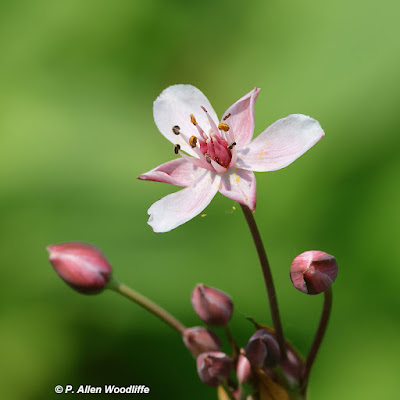Certainly the most intriguing bird of recent days was the occurrence of a Lark Bunting, seen at the grassy/shrubby pasture along Stefina Line. It is a young male due to the brownish feathers above the obvious white ones in the wing. It is possible it showed up here due to the very dry conditions in its normal western range, and also perhaps of the air quality caused by the proliferation of wildfires.
This first photo shows what it typically looks like as it perches on a fence post. I was fortunate to take this photo in Grasslands National Park, in southern Saskatchewan a few years ago.Even though I spent several hours over a couple of days watching this particular bird at the pasture, the photos I got were not as high quality as I was hoping for. It spent most of its time 100 metres or more well out in the pasture, and although it was observed doing its aerial flight and singing, it seldom came very close. There were many dozens of birders from various parts of Ontario that lined up along the road, to see this unusual species, and in looking at the photos posted on eBird, occasionally someone would get a fairly close photo when the bird stopped by at a good spot for at least a few seconds. Here are a couple of my photos that I managed to get. This first one is when it landed on a steel gate by the corral.
This next one is when it was perched on one of several of its favourite shrubs a long way out. Both photos are heavily cropped.The Lark Bunting is officially considered Threatened in Canada, and is limited to the western prairie regions, most commonly in southern Alberta and Saskatchewan. It is more abundant in the mid-western USA.
As I was waiting for better photo ops, I managed to get this dragonfly perched on some grass by the road.
 |
| Widow Skimmer |
 |
| Halloween Pennant |
 |
| Blue Dasher |
I got a few birds along the way, either at this NWA or on another day at the similar type of habitat a bit farther north, at the Mitchell's Bay North Shore Trail. This first one is an adult Bald Eagle that for some reason was hanging out along the roadside. It probably was after something in the canal immediately adjacent to the road, but after allowing me to get a couple of photos, it decided to move on, so I did also.
This Eastern Kingbird cooperated nicely before heading off to chase an insect.The adjacent wetlands are often used by Great Blue Herons.......and Great Egrets, that are always fun photo opportunities.A critter that isn't often up and visible is this Groundhog, that paused momentarily on the trail before scampering out of sight.Of course Killdeer are quite common.......and Red-winged Blackbirds are super abundant, but don't always like sitting up for a good photo at a close distance. They are often busy squawking about something........or just hanging out, perhaps keeping an eye on a nearby nest.
If the birds don't cooperate, there are usually other things that are more tolerant of my approach, such as this Yellow Iris, attractive but not native.
This female Northern Map Turtle was busy laying eggs along the side of the trail. Usually if a turtle is well underway in the egg-laying state, it will remain tolerant, unless it feels particularly threatened. I just walked quietly by, got a photo, and let her carry on. Hopefully more of this near threatened species will be emerging from the nest in a few months!This Northern Blue Flag, in the same family as the Yellow Iris shown earlier, is a common native species found in wetland areas.Next is a large bracket-type fungus called Dryad's Saddle.Flowering Rush is another common, but not native wildflower common in or adjacent to wetlands.If you would like to subscribe or unsubscribe to Nature Nuggets, send an email to: prairietramper@gmail.com



















No comments:
Post a Comment